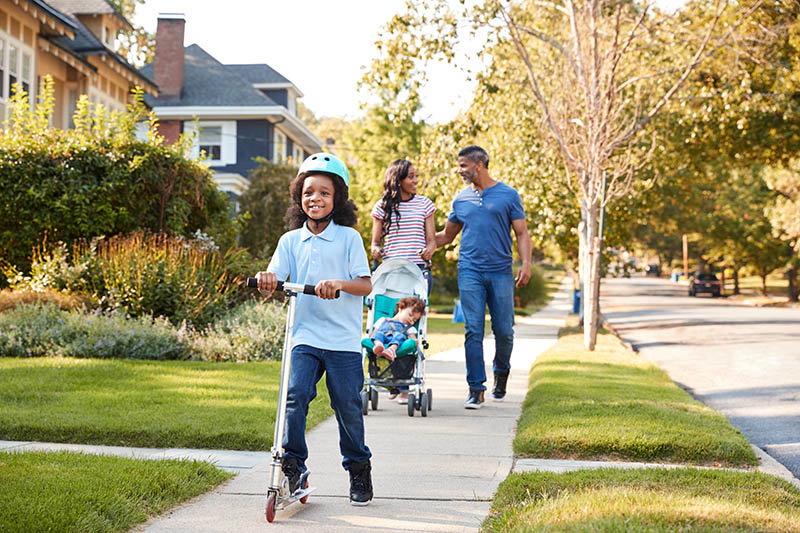
27 Sep How to Choose the Perfect Neighborhood
How to Choose the Perfect Neighborhood: What to Look For When Buying a Home
Buying a home is one of the biggest investments you’ll ever make, and while factors like home size, style, and price are essential, the neighborhood you choose is equally—if not more—important. A home’s location can greatly impact your lifestyle, your family’s comfort, and even the future resale value of your property. But with so many factors to consider, how do you know which neighborhood is right for you?
This guide will walk you through what to look for when choosing the perfect neighborhood for your new home. Whether you’re a first-time homebuyer, relocating for work, or looking for a place to settle down with your family, understanding the key elements that make a great neighborhood will help you make a well-informed decision.
1. Proximity to Work and Daily Commute
One of the first things to consider when selecting a neighborhood is the distance to your workplace. A shorter commute can significantly improve your quality of life by saving time, reducing stress, and allowing more time for family and leisure. Before committing to a neighborhood, map out the route from the potential home to your workplace.
Key Factors to Consider:
- Commute Time: How long will it take you to get to work during rush hours? Consider using a navigation app to estimate commute times at different times of day.
- Access to Public Transit: If you prefer not to drive, is the neighborhood well-served by public transportation options such as buses, trains, or subways?
- Future Work Flexibility: If you work remotely or have a flexible schedule, proximity to work may be less of an issue, but access to reliable internet and coworking spaces can still be important.
2. Safety and Crime Rates
Safety is a primary concern for most homebuyers. No matter how beautiful or affordable a neighborhood may be, living in an area with high crime rates can severely impact your peace of mind. Researching crime statistics is a must before deciding on a neighborhood.
How to Evaluate Neighborhood Safety:
- Local Crime Reports: Websites like NeighborhoodScout, City-Data, and government police reports can provide insight into crime rates in specific neighborhoods.
- Personal Visits: Visit the area at different times of day (daytime and nighttime) to get a feel for the safety and atmosphere. Don’t hesitate to talk to potential neighbors to ask about their experiences.
- Community Safety Programs: Check if the neighborhood has active neighborhood watch programs or police patrols to deter crime.
3. Schools and Education
If you have children—or plan to in the future—the quality of local schools will be one of the most important factors in choosing a neighborhood. A good school district can also significantly increase the resale value of your home, even if you don’t have kids.
Key Things to Look For:
- School Ratings: Websites like GreatSchools or Niche provide school rankings based on test scores, reviews, and other factors.
- School Proximity: How close are the schools to your potential home? Long commutes can add stress to the daily routine.
- School Programs: Consider the quality of extracurricular activities, sports programs, and arts education. Are there reputable daycare centers, preschools, and after-school programs nearby?
4. Neighborhood Amenities
The right neighborhood should offer the amenities that align with your lifestyle and needs. Think about what you and your family value most in terms of leisure, entertainment, and services.
Essential Amenities to Consider:
- Parks and Recreation: Access to green spaces, playgrounds, sports facilities, and nature trails can enhance your outdoor activities and family time.
- Shopping and Dining: How convenient is the neighborhood to grocery stores, restaurants, and retail shopping? Are there farmers’ markets or specialty food stores nearby?
- Healthcare Facilities: Are there hospitals, urgent care centers, and pharmacies close by for routine check-ups or emergencies?
- Entertainment and Culture: If you enjoy cultural activities, are there theaters, museums, music venues, or other forms of entertainment in the area?
- Community Centers: Consider the availability of local clubs, recreation centers, and libraries that foster a sense of community.
5. Neighborhood Character and Atmosphere
Every neighborhood has its own unique vibe and personality, and it’s important to find one that matches your lifestyle. Some areas may be bustling and lively, while others are quieter and more residential. Think about the kind of atmosphere you want in your day-to-day life.
Key Factors to Assess Neighborhood Character:
- Noise Levels: Spend time in the neighborhood to gauge the noise level. Is it peaceful or constantly buzzing with activity? Noise from nearby highways, train tracks, or airports can affect your comfort.
- Community Feel: Is the neighborhood family-friendly, young and trendy, or retirement-oriented? Are there community events and activities that foster social interaction?
- Aesthetic Appeal: Pay attention to the upkeep of homes, gardens, and public spaces. Well-maintained neighborhoods indicate pride of ownership and stability.
- Cultural Diversity: Consider whether you want a neighborhood with a rich cultural mix, as this can affect everything from local cuisine to events and festivals.
6. Future Development and Growth Potential
When buying a home, it’s wise to think about not just the present, but the future of the neighborhood. Neighborhoods that are up-and-coming or are planned for future development can provide significant benefits in the long term, including increased property values.
How to Assess Future Growth:
- Local Zoning Plans: Check with city planners or real estate agents to see if there are upcoming developments such as new shopping centers, office buildings, or parks. These can increase the value of your home.
- Gentrification Trends: Be aware of neighborhoods in the early stages of gentrification, which can bring improvements to infrastructure and local businesses but may also lead to higher property taxes and cost-of-living increases.
- Infrastructure Projects: Are there new highways, public transit lines, or airports being built nearby? While this can increase accessibility, it may also bring unwanted noise and congestion.
7. Affordability and Housing Costs
Your dream neighborhood needs to fit within your budget. Even if you find the perfect place, high property taxes, homeowners association (HOA) fees, or rising housing prices can quickly strain your finances.
Factors to Consider Regarding Housing Costs:
- Property Values: Research current home prices in the neighborhood and check recent trends. Are prices rising or stable?
- Property Taxes: Property tax rates vary widely from one area to another. Make sure to factor taxes into your budget when calculating your monthly expenses.
- HOA Fees: Some neighborhoods, particularly in planned communities or condominiums, require HOA fees for maintenance of common areas and amenities. Be sure to check if these fees fit your budget.
- Utilities and Services: Don’t forget to research the cost of utilities, including electricity, water, and gas, which can vary by neighborhood.
8. Walkability and Transportation
If you enjoy walking or biking, a neighborhood’s walkability score should be on your radar. Being close to local shops, schools, and public transport can enhance your lifestyle and save money on car expenses.
Key Transportation Considerations:
- Walkability: Use websites like Walk Score to determine how walkable a neighborhood is. High walkability means you can reach most services and amenities on foot.
- Public Transit Access: Even if you primarily drive, having good access to public transportation can be beneficial, especially if gas prices rise or you need an alternative commuting option.
- Bike-Friendly Infrastructure: Does the neighborhood have bike lanes, bike-sharing programs, or trails? This is especially important if you’re looking for an eco-friendly commute.
9. Resale Value and Long-Term Investment
While it’s important to love where you live, it’s also essential to think about the resale value of your home. Will the neighborhood continue to grow and attract future buyers? Buying in a stable or appreciating area can protect your investment and give you better returns when you eventually sell.
Consider These Long-Term Investment Factors:
- Local Real Estate Trends: Look at historical data to see how property values have changed over time. Neighborhoods with steady price growth are safer investments.
- School District: Homes in highly rated school districts tend to hold their value better, even during market downturns.
- Neighborhood Stability: Established neighborhoods with long-term residents are generally more stable and provide a safer investment than areas with high turnover.
Final Thoughts
Choosing the perfect neighborhood involves more than just finding the right house—it’s about finding the right community for your lifestyle and future goals. By considering factors like safety, amenities, schools, and long-term growth, you can narrow down your options and find a neighborhood that meets your needs today and tomorrow. Taking the time to research, visit, and think about the future will ensure you make a sound investment in a place you’ll love to call home.

